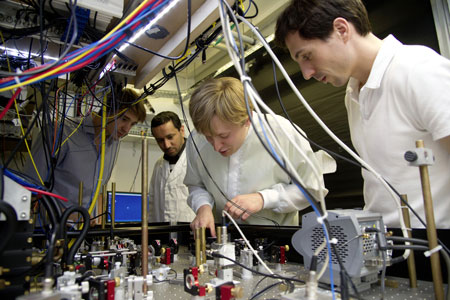| Jun 05, 2012 |
Splitting the unsplittable
|
|
(Nanowerk News) Researchers from the University of Bonn have just shown how a single atom can be split into its two halves, pulled apart and put back together again. While the word "atom" literally means "indivisible," the laws of quantum mechanics allow dividing atoms - similarly to light rays - and reuniting them. The researchers want to build quantum mechanics bridges by letting the atom touch adjacent atoms while it is being pulled apart so that it works like a bridge span between two pillars. The results have just been published in the journal Proceedings of the National Academy of Sciences ("A digital atom interferometer with single particle control on a discretized space-time geometry").
|
|
Dividing atoms? What sounds like nuclear fission and radioactivity is, however, a precision process using quantum mechanics. The laws of quantum mechanics allow objects to exist in several states simultaneously. This is what the so-called double-slit experiment is based on, where a particle can go through two slits at the same time. The Bonn scientists working with Prof. Dr. Dieter Meschede from the Institute for Applied Physics of the University of Bonn succeeded in keeping a single atom simultaneously in two places that were more than ten micrometers, or one hundredth of a millimeter, apart. This is an enormous distance for an atom. Afterwards, the atom was put back together undamaged.
|
 |
| Teilen mit quantenmechanischer Präzisionsarbeit Atome: Maximilian Genske, Noomen Belmechri, Andreas Steffen und Dr. Andrea Alberti (von links) im Labor.
|
|
The atom has a split personality
|
|
The fragile quantum effects can only occur at the lowest temperatures and with careful handling. One method is cooling a cesium atom enormously using lasers – to a temperature of a tenth of a million above absolute zero – and then holding it with another laser. This laser beam is key to splitting the atom. It works because atoms have a spin that can go in two directions. Depending on the direction, the atom can be moved to the right or the left by the laser like on a conveyor. Key is that the atom's spin can be in both directions simultaneously. So, if the atom is moved to the right and left at the same time, it will split. "The atom has kind of a split personality, half of it is to the right, and half to the left, and yet, it is still whole," explained Andreas Steffen, the publication's lead author.
|
|
The parts compare their "experiences"
|
|
But you cannot see the split directly; if you shine a light on the atom to take a picture, the split will collapse immediately. The atom can then be seen in several images; sometimes on the left, sometimes on the right - but never in both places. And yet, the split can be proved successfully by putting the atom back together. Thus an interferometer can be built from individual atoms that can, e.g., be used to measure external impacts precisely. Here, the atoms are split, moved apart and joined again. What will become visible, e.g., are differences between the magnetic fields of the two positions or accelerations since they become imprinted in the quantum mechanical state of the atom. This principle has already been used to very precisely survey forces such as the earth's acceleration.
|
|
Quantum systems as tools?
|
|
The Bonn scientists, however, are looking for something else: simulating complex quantum systems. Many physicists have been hoping for a long time to be able to simulate so-called topological isolators or plant photosynthesis – phenomena that are hard to capture with modern super computers – using small quantum systems. The first steps on the way to such simulators could consist of modeling the movement of electrons in solid bodies, thus gaining insights for innovative electronic devices. Examples for this are Dirac motion of electrons in a single graph-layer or the emergence of artificial molecules from interacting particles. But for this purpose, individual atoms would not only have to be well controlled, but also linked according to quantum mechanical laws since where the crux of the matter lies is exactly in a structure made up from many quantum objects.
|
|
A cog in a gearbox
|
|
"For us, an atom is a well-controlled and oiled cog," said Dr. Andrea Alberti, the team lead for the Bonn experiment. "You can build a calculator with remarkable performance using these cogs, but in order for it to work, they have to engage." This is where the actual significance of splitting atoms lies: Because the two halves are put back together again, they can make contact with adjacent atoms to their left and right and then share it. This allows a small network of atoms to form that can be used – like in the memory of a computer – to simulate and control real systems, which would make their secrets more accessible. The scientists believe that the entire potential of controlling individual atoms this precisely will become apparent over time.
|

